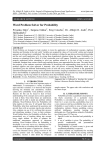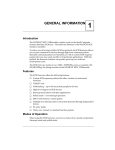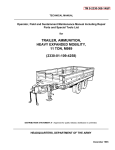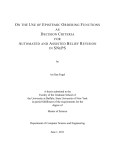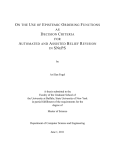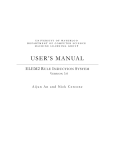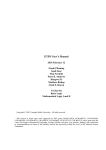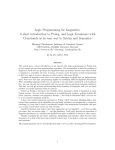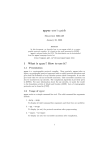Download Local Users Guide to Theorist
Transcript
Local Users Guide to Theorist∗ David Poole Department of Computer Science, University of British Columbia, Vancouver, B. C., Canada V6T 1W5. (604) 228-6254 [email protected] December 15, 2009 Abstract Theorist [Poole88, PGA87, Poole89, Poole90] is a logical reasoning system for default reasoning and diagnosis. It is based on the idea of theory formation from a fixed set of possible hypotheses. This is a users manual for a compiler from Theorist to Prolog. This code is as described in [Poole91]. This compiler should not be seen as “the” theorist system, but of one (rather simple and naive) implementation of the Theoirst framework. For example, it finds all explanations of the given goal, and does no simplification of the explanations. Contents 1 Introduction 2 2 Theorist Framework 2.1 Syntax . . . . . . . . . . . . . . . . . . . . . . . . . . . . . . . 2.2 Compiler Directives . . . . . . . . . . . . . . . . . . . . . . . . 2.3 Flags . . . . . . . . . . . . . . . . . . . . . . . . . . . . . . . . 2 3 5 5 ∗ c Copyright 1990 David Poole. All rights reserved. 1 A Theorist User’s Guide 3 Examples 3.1 Default Reasoning . 3.2 Cancelling Defaults . 3.3 Disjunctive Answers 3.4 circuits . . . . . . . . 3.5 Prediction . . . . . . 2 . . . . . . . . . . . . . . . . . . . . . . . . . 4 Conclusion 1 . . . . . . . . . . . . . . . . . . . . . . . . . . . . . . . . . . . . . . . . . . . . . . . . . . . . . . . . . . . . . . . . . . . . . . . . . . . . . . . . . . . . . . . . . . 6 6 8 9 10 13 15 Introduction This paper describes the use of the Theorist compiler. To run this you must have access to a machine with Sicstus Prolog or Quintus Prolog, or many other Prologs that are similar. It is meant to be portable. When you execute this, you can type Theorist commands at it. N.B. you can also type Prolog queries at it; the Theorist commands will just be Prolog queries. The source code is in the file theorist.tex This can either be consulted as a Prolog program or typeset as a Latex document with only one character editing at the start of the file. 2 Theorist Framework Theorist [Poole88, PGA87, Poole89, Poole90] is a logical reasoning system for default reasoning and diagnosis. It is based on the idea of theory formation from a fixed set of possible hypotheses. This implementation is of the version of Theorist described in [Poole91]. The user provides three sets of first order formulae F is a set of closed formulae called the facts. These are intended to be true in the world being modelled. ∆ is a set of formulae which act as possible hypotheses, any ground instance of which can be used in an explanation if consistent. A Theorist User’s Guide 3 C is a set of closed formulae taken as constraints. The constraints restrict what can be hypothesised. We assume that F ∪ C is consistent. Definition 1 a scenario of F, ∆ is a set D ∪ F where D is a set of ground instances of elements of ∆ such that D ∪ F ∪ C is consistent. Definition 2 If g is a closed formula then an explanation of g from F, ∆ is a scenario of F, ∆ which implies g. That is, g is explainable from F, ∆ if there is a set D of ground instances of elements of ∆ such that F ∪ D |= g and F ∪ D ∪ C is consistent F ∪ D is an explanation of g. In other papers we have described how this can be the basis of default and abductive reasoning systems [PGA87, Poole88, Poole89, Poole90]. If we are using this for prediction then possible hypotheses can be seen as defaults. [Poole88] describes how this formalism can account for default reasoning. This is also a framework for abductive reasoning where the possible hypotheses are the base causes we are prepared to accept as to why some observation was made [PGA87, Poole89, Poole90]. We will refer to possible hypotheses as defaults. One restriction that can be made with no loss of expressive power is to restrict possible hypotheses to just atomic forms with no structure [Poole88]. This is done by naming the defaults. 2.1 Syntax The syntax of Theorist is designed to be of maximum flexibility. Virtually any syntax is appropriate for wffs; the formulae are translated into Prolog clauses without mapping out subterms. The theorem prover implemented in the Compiler can be seen as a non-clausal theorem prover [Poole84]. A wff is a well formed formula made up of arbitrary combination of implication (“=>”, “< −”), disjunction (“or”, “;”), conjunction (“and”, A Theorist User’s Guide 4 “&”, “,”) and negation (“not”, “˜”) of atomic symbols. Variables follow the Prolog convention of being in upper case. There is no explicit quantification. A name is an atomic symbol with only free variables as arguments. The following gives the syntax of the Theorist code: fact w. where w is a wff, means that (∀w) ∈ F; i.e., the universal closure of w (all variables universally quantified) is a fact. default d. where d is a name, means that d ∈ ∆; i.e., d is a default (a possible hypothesis). default d : w. where d is a name and w is a wff means w, with name d can be used in a scenario if it is consistent. Formally it means d ∈ ∆ and (∀d ⇒ w) ∈ F. constraint w. where w is a wff means ∀w ∈ C. prolog p. where p is an atomic symbol means any Theorist call to p should be proven in Prolog. This allows us to use built-in predicates of pure Prolog. One should not expect Prolog’s control predicates to work. explain w. where w is an arbitrary wff, gives all explanations of ∃w. predict w. where w is a arbitrary ground wff, returns “yes” if w is in every extension of the defaults and “no” otherwise. If it returns “yes”, a set of explanations is returned, if it returns “no” then a scenario from which g cannot be explained is returned (this follows the framework of [Poole89]). In this compiler these are interpreted as commands to Prolog. The interface will thus be the Prolog interface with some predefined commands. A Theorist User’s Guide 2.2 5 Compiler Directives The following are compiler directives: thconsult filename. reads commands from filename, and asserts and/or executes them. thtrans filename. reads commands from filename and translates them into Prolog code in the file filename.pl. thcompile filename. reads commands from filename, translates them into the file filename.pl and then compiles this file. “explain” commands in the file are not interpreted. dyn atom. should be in a file and declares that anything matching the atom is allowed to be asked or added to. This should appear before any use of the atom. This corresponds to the “dynamic” declaration of Quintus Prolog. This is ignored except when compiling a file. 2.3 Flags There are some other commands which allow one to set flags. There are a number of Theorist options which can be set by flag declarations. Flags, by default, are on. To set the flag f to value v you can issue the command set f, v. To find out the value of the flag f issue the command flag f, V. You can reset the value of flag f to its old value by reset f. The following flags currently do something: A Theorist User’s Guide 6 ancestor search when on means that we check for ancestors. If this is off we lose completeness for the general formula case. If we are only using Horn clauses then we do not need an ancestor search. loop check this turns on a simple loop check. It makes the system propositionally complete. The overhead for long loops may be very high though. If your program runs very slowly, then turn it off. Often dramatic improvements can be acheived in this way. It does not affect correctness of answers found. asserting when on, this asserts the compiled clauses into Prolog, when off it writes the Prolog form of the assertions onto the standard output. This is mainly used internally, but is useful for seeing the output of the Theorist compiler. 3 Examples This section contain many examples. The best source of descriptions of more examples is [Poole90]. 3.1 Default Reasoning The following example is a file to do the birdsfly example dyn flies(X). dyn bird(X). default birdsfly(X): flies(X) <- bird(X). constraint not birdsfly(X) <- not flies(X). default emusdontfly(X): not flies(X) <- emu(X) . constraint not emusdontfly(X) <- flies(X). constraint not birdsfly(X) <- emu(X). fact bird(X) <- emu(X). fact bird(X) <- robin(X). fact bird(tweety). fact emu(polly). fact robin(cohen). A Theorist User’s Guide 7 The following is a session with theorist. We assume that the preceeding code is in a file called “birdsfly”. theorist Welcome to THEORIST 1.1 (5 October 88 version) Any Problems see David Poole ([email protected]) yes | ?- thconsult birdsfly. yes | ?- explain flies(tweety). Answer is flies(tweety) Theory is [birdsfly(tweety)] no | ?- explain flies(polly). no | ?- explain flies(X). Answer is flies(cohen) Theory is [birdsfly(cohen)] Answer is flies(tweety) Theory is [birdsfly(tweety)] no | ?Note that the explain command always finds all answers and then returns with “no” (note that, for simplicity, it is a Prolog command). Note also that we did a “thconsult”; we could have also done a “thcompile” but it would have taken longer to load the file, but would have executed quicker. Note also that if we had typed the commands at the terminal (which is the same A Theorist User’s Guide 8 a “thconsult”ing them, but not “thcompile”ing them, then we did not need the “dyn” declaration). 3.2 Cancelling Defaults We can do a more complicated example to show cancelling defaults dyn flies(X). default mammals_dont_fly(X): not flies(X) <- mammal(X). constraint not mammals_dont_fly(X) <- flies(X). default bats_fly(X): flies(X) <- bat(X). constraint not bats_fly(X) <- not flies(X). constraint not mammals_dont_fly(X) <- bat(X). default dead_things_dont_fly(X): not flies(X) <- dead(X). constraint not dead_things_dont_fly(X) <- flies(X). constraint not bats_fly(X) <- dead(X). fact mammal(X) <- bat(X). fact mammal(bruce). fact bat(paul). fact bat(dracula). fact dead(dracula). Give that file we can do the following | ?- explain flies(X). Answer is flies(paul) Theory is [bats_fly(paul)] no | ?- explain not flies(X). Answer is not flies(bruce) Theory is [mammals_dont_fly(bruce)] Answer is not flies(dracula) Theory is [dead_things_dont_fly(dracula)] no A Theorist User’s Guide 3.3 9 Disjunctive Answers Consider the following session | ?- fact p(a) or p(b). yes | ?- fact p(X) and not q(f(X)) => q(X). X = _38 | ?- explain p(X). Answer is p(a) or p(b) Theory is [] Answer is p(b) or p(a) Theory is [] no | ?- explain q(X). Answer is q(a) or q(f(b)) or q(b) or q(f(a)) Theory is [] Answer is q(b) or q(f(a)) or q(a) or q(f(b)) Theory is [] Answer is q(f(a)) or q(f(b)) or q(b) or q(a) Theory is [] Answer is q(f(b)) or q(f(a)) or q(a) or q(b) Theory is [] no Note that we get different orderings from the disjunct. This is because the linear resolution method used finds each of the proofs with each of the A Theorist User’s Guide 10 disjuncts as head, and we do not simplify the results. 3.4 circuits This specifies an abductive program for the full adder: % a circuit diagnosis program for a full adder dyn diag(X,Y). dyn val(X,Y). % to use add in facts about the input of the circuit, such as % fact val(in(1, f1), off). % fact val(in(2, f1), off). % fact val(in(3, f1), off). % to get it to explain the output of the circuit do something lik % diag(on, on). fact fact fact fact fact gate(x1, gate(x2, gate(a1, gate(a2, gate(o1, xor). xor). and). and). or). fact fact fact fact fact fact fact fact fact fact fact fact conn(in(1, f1), in(1, x1)). conn(in(1, f1), in(1, a1)). conn(in(2, f1), in(2, x1)). conn(in(2, f1), in(2, a1)). conn(in(3, f1), in(2, x2)). conn(in(3, f1), in(1, a2)). conn(out(1, x1), in(1, x2)). conn(out(1, x1), in(2, a2)). conn(out(1, a1), in(2, o1)). conn(out(1, a2), in(1, o1)). conn(out(1, x2), out(1, f1)). conn(out(1, o1), out(2, f1)). fact val(in(N, Device), anything). A Theorist User’s Guide default ok(Device). fact val(out(1, Device), Out1) <ok(Device), gate(Device, Type), ttable(Type, In1, In2, Out1), val(in(1, Device), In1), val(in(2, Device), In2). default faulty(Device). fact val(out(1, Device), Out1) <faulty(Device), gate(Device, Type), ttable(Type, In1, In2, Eout), opp(Eout, Out1), val(in(1, Device), In1), val(in(2, Device), In2). fact n(ok(Device)) <- faulty(Device). fact opp(on, off). fact opp(off, on). fact fact fact fact fact fact fact fact fact ttable(and, on, on, on). ttable(and, off, anything, off). ttable(and, anything, off, off). ttable(or, off, off, off). ttable(or, on, anything, on). ttable(or, anything, on, on). ttable(xor, off, on, on). ttable(xor, off, off, off). ttable(xor, on, X, Y) <- opp(X, Y). fact val(Y, Z) <ne(Z, anything), conn(X, Y), 11 A Theorist User’s Guide val(X, Z). % define enough of "ne" - not equals - to make this work ne(on,anything ). ne(off,anything ). fact n(val(X, off)) <- val(X, on). fact diag(Out1, Out2) <val(out(1, f1), Out1 ), val(out(2, f1), Out2 ). We can do circuit diagnosis: | ?- thcompile cir2. [compiling /ubc-lcvfs1/poole/theorist/cir2.pl...] [cir2.pl compiled 10.133 sec 29,868 bytes] yes | ?- fact val(in(1, f1), off). yes | ?- fact val(in(2, f1), off). yes | ?- fact val(in(3, f1), off). yes | ?- explain diag(on,on). Answer is diag(on,on) Theory is [faulty(a2),ok(o1),faulty(x1),ok(x2)] Answer is diag(on,on) Theory is [faulty(a1),ok(o1),faulty(x1),ok(x2)] Answer is diag(on,on) 12 A Theorist User’s Guide Theory is [faulty(a1),ok(o1),faulty(x1),ok(x2)] Answer is diag(on,on) Theory is [ok(a1),ok(a2),faulty(o1),faulty(x1),ok(x2)] Answer is diag(on,on) Theory is [ok(a1),ok(a2),faulty(o1),faulty(x1),ok(x2)] Answer is diag(on,on) Theory is [faulty(a2),ok(o1),ok(x1),faulty(x2)] Answer is diag(on,on) Theory is [faulty(a2),ok(o1),ok(x1),faulty(x2)] Answer is diag(on,on) Theory is [faulty(a1),ok(o1),ok(x1),faulty(x2)] Answer is diag(on,on) Theory is [faulty(a1),ok(o1),ok(x1),faulty(x2)] Answer is diag(on,on) Theory is [ok(a1),ok(a2),faulty(o1),ok(x1),faulty(x2)] Answer is diag(on,on) Theory is [ok(a1),ok(a2),faulty(o1),ok(x1),faulty(x2)] Answer is diag(on,on) Theory is [ok(a1),ok(a2),faulty(o1),ok(x1),faulty(x2)] Answer is diag(on,on) Theory is [ok(a1),ok(a2),faulty(o1),ok(x1),faulty(x2)] no 3.5 Prediction We predict what is in every extension. 13 A Theorist User’s Guide 14 default quaker_so_dove(X): quaker(X) => dove(X). default republican_so_hawk(X): republican(X) => hawk(X). default hawk_so_motivated(X): hawk(X) => motivated(X). default dove_so_motivated(X): dove(X) => motivated(X). default dove_so_peaceful(X): dove(X) => peaceful(X). fact not (hawk(X) and dove(X)). fact republican(ron). fact quaker(george). fact republican(dick). fact quaker(dick). The following tracing shows how prediction works. | ?- predict motivated(ron). Yes, motivated(ron) is in all extensions. Explanations are: 1: [hawk_so_motivated(ron),republican_so_hawk(ron)]. yes | ?- predict hawk(ron). Yes, hawk(ron) is in all extensions. Explanations are: 1: [republican_so_hawk(ron)]. yes | ?- predict motivated(dick). Yes, motivated(dick) is in all extensions. Explanations are: 1: [dove_so_motivated(dick),quaker_so_dove(dick)]. 2: [hawk_so_motivated(dick),republican_so_hawk(dick)]. yes | ?- predict hawk(dick). No, hawk(dick) is not explainable from [quaker_so_dove(dick)]. yes | ?- predict peaceful(dick). No, peaceful(dick) is not explainable from [republican_so_hawk(dick)]. A Theorist User’s Guide 15 yes | ?- predict peaceful(george). Yes, peaceful(george) is in all extensions. Explanations are: 1: [dove_so_peaceful(george),quaker_so_dove(george)]. yes 4 Conclusion Any comments about the product or the manual please direct to the author. Have fun. Acknowledgements This work could not have been done without the ideas, criticism and feedback from Randy Goebel, Eric Neufeld, Paul Van Arragon, Scott Goodwin and Denis Gagné. Thanks to Brenda Parsons and Amar Shan for valuable comments on a previous version of this paper. This research was supported under NSERC grant A6260. References [Poole84] D. Poole, “Making Clausal theorem provers Non-clausal”, Proc. CSCSI-84. pp. 124-125. [Poole88] D. Poole, “A Logical Framework for Default Reasoning”, Artificial Intelligence 36(1), 27–47, 1988. [Poole89] D. Poole, “Explanation and prediction: an architecture for default and abductive reasoning”, Computational Intelligence 5(2), 97–110, 1989. A Theorist User’s Guide 16 [Poole90] D. Poole, “A methodology for using a default and abductive reasoning system”, International Journal of Intelligent Systems 5(5), 521–548, 1990. [Poole91] D. Poole, “Compiling a Default Reasoning System into Prolog”, New Generation Computing, 9(1), 3–38, 1991. [PGA87] D. L. Poole, R. G. Goebel and R. Aleliunas, “Theorist: A Logical Reasoning System for Defaults and Diagnosis”, in N. Cercone and G. McCalla (Eds.) The Knowledge Frontier: Essays in the Representation of Knowledge, Springer Varlag, New York, 1987, pp. 331-352.
















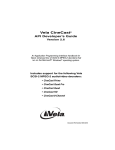
![catalogue_pdf [1.82] Mo - Enseirb](http://vs1.manualzilla.com/store/data/006360324_1-6d38883db81245c16ae9c413a1d8cfa1-150x150.png)



